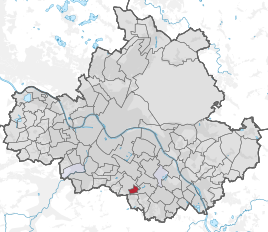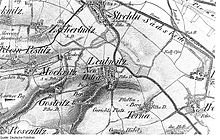Torna (Dresden)
|
Torna
District of the state capital Dresden
Coordinates: 51 ° 0 ′ 24 ″ N , 13 ° 46 ′ 42 ″ E
|
|
|---|---|
| Height : | 150 m above sea level NN |
| Incorporation : | June 1, 1921 |
| Postal code : | 01239 |
| Area code : | 0351 |
|
Location of the Torna district in Dresden
|
|
Torna is a district in the southeast of the Saxon capital Dresden . It is located near the outskirts in the district of the same name , which belongs to the Prohlis district.
geography
Torna is located 5 km south-east of Dresden city center, the inner old town , on the flat slopes of the Elbe valley , which slowly rise to the south . Neighboring districts are the other Dresden districts Leubnitz-Neuostra in the west and north and Prohlis in the east and south. With Reick , Nickern and Kauscha, there are other parts of the city in the immediate vicinity, but they are not directly adjacent. The Torna district belongs to the statistical district of Leubnitz-Neuostra . The center of Alttorna is at a height of 150 m above sea level. NN and thus noticeably above the valley floor of the Elbe . Some of his farms have survived to this day. There are housing estates in the northeast and west of the Tornaer Flur.

The south of the district, on the other hand, is characterized by large pits in which the loess clay layer up to 10 m thick is industrially mined. In the ground under Torna there are also layers of plan and set marl to music . You are open-minded in the Torna brickworks ; the area in question with a size of 0.3 hectares was designated as a natural monument ND 22 , as fossils also came to light here . When the clay was broken down, bone remnants of woolly rhinoceros and mammoths were found . A loess profile was also recorded in the Torna brickworks , which shows the two main advances of the Vistula Ice Age. Consist east of Torna also smaller than mining relics opencast mining holes or lakes . Some of them are also under protection under the name ND 53 Tornaer Lehmgruben with a total area of 4.8 hectares, as all three native green frog and a total of 64 bird species can be found in this biotope , such as the little grebe , puffy tit , marsh warbler and kingfisher .
The most important street in Torna is Staatsstraße 172 , which under the name Dohnaer Straße touches the district to the northeast and via which a connection to the city center can be established in a 10-minute drive. The Tornaer Strasse / Alttorna road branches off from here, opening up the district and connecting it with Leubnitz and Reick. The Kauschaer Straße in the southwest, however, leads to Kauscha. The other named streets in Torna are called Tornaer Ring, Heimstattweg, Am Goldenen Stiefel, Am Dorngraben and Röntgenstraße. Public transport is the bus lines 66, 75 and 87 of the Dresdner Verkehrsbetriebe .
history
The village of Torna emerged as a street village-like peasant hamlet and was equipped with a block and striped corridor. The place name is of Slavic origin and is probably derived from Torn , the Old Sorbian word for thorn . Correspondingly, Torna means place on the thorn bushes (cf. Trnava ). It was first mentioned as Turnow in 1347 , when Margrave Friedrich the Serious met the widow Vikos, Adelheid von Donin , née. von Waldenburg, with today's Heidenau district Mügeln and with Torna enfeoffed. The place name then developed in the 16th century via the forms Tornaw , Dorn and Thorna to Dornau , which is called in 1678. In 1541 the chronicle also reports on Thornische Huffe ("Tornaer Hufen )"; In the old community seal there is also the form Dorna . The current spelling of the district appears for the first time in 1781.
Initially, Torna, which included only a few farmsteads, was owned by the Leubnitz monastery, which in turn was subordinate to the Altzella monastery. It is recorded from 1382 that Nikolaus I. the billy goat , the then bishop of Meissen , had to settle a dispute between the monastery property and the pastor of Leubnitz over the rights of use of the Torna fields. After the Reformation , the Prokuraturamt in Leubnitz became the administrator of the former property of the Catholic Church in 1539. Torna was also parish after Leubnitz; the Torna children also went to the local school until around 1890 a school community was formed with Reick. Administratively, Torna belonged to the office or to the administrative authority of Dresden . Its residents had to do their best in addition to the compulsory labor and taxes ; after the death of the farmer the landlord received his best horse and, in the event of the death of the farmer's wife, the most productive cow on the farm.
A few years after the Reformation in 1547, all seven hooves in the village lay desolate ; the reasons for this are not known. Around 1564 the fields were then cultivated by the farmers of neighboring Prohlis. Torna was later repopulated; After the severe destruction of the Thirty Years' War and several plague epidemics in the following century, the village recovered only slowly. There was renewed damage when several Torna buildings burned down in the course of the Battle of Dresden , which raged in the southern suburbs of Dresden in August 1813.
The year 1815 is considered to be the year the Torna restaurant, Goldener Stiefel, opened . It was initially housed in Hof Alttorna 5 and from 1826 was owned by a shoemaker, after whose death his son-in-law had a new building built on Pfaffenberg in 1876/77. Around 1900 this was the local mountain club for Saxon Switzerland . Richard Wagner is said to have been a guest in the previous building in the 1840s.
At first, agriculture was the main source of income for the local farmers. In the course of the 19th century, the areas available for this were gradually lost in favor of clay pits and brickworks . At the nearby 185 m high Gamighübel, residents of Torna, Kauscha and Leubnitz operated quarries , in which they mined Dohna granodiorite .
At the beginning of the 20th century , Torna planned a merger with Leubnitz-Neuostra, but this did not materialize. Subsequently, on June 1, 1921, it was incorporated into Dresden . As a result, new settlements with private individual houses emerged, which is why Torna eventually merged with Leubnitz-Neuostra in the west and Prohlis in the northeast. The sports field Torna on Dohnaer Straße is the home of SV Eintracht Strehlen .
Population development
| year | Residents |
|---|---|
| 1554 | 2 possessed man |
| 1642 | 2 possessed man |
| 1648 | 4 obsessed man |
| 1764 | 7 possessed men, 1 cottage owner |
| 1834 | 61 |
| 1867 | 57 |
| 1871 | 85 |
| 1890 | 130 |
| 1910 | 209 |
| 1921 | 192 |
See also
Individual evidence
- ↑ dresden-lexikon.de
- ↑ a b c Kai Tempel: Dresden-Torna. (No longer available online.) Archived from the original on March 4, 2016 ; Retrieved October 27, 2013 . Info: The archive link was inserted automatically and has not yet been checked. Please check the original and archive link according to the instructions and then remove this notice.
- ↑ springerlink.de
- ↑ Protected areas according to the Nature Conservation Act. (PDF; 155 kB) In: Environmental Atlas 04/2008. Environmental Office of the State Capital Dresden, p. 5 f. (in PDF) , accessed on October 27, 2013 .
- ↑ Dresden line network. (PDF file, 631 KB) Dresdner Verkehrsbetriebe, September 23, 2013, accessed on October 27, 2013 .
- ^ Districts of Leubnitz-Neuostra, Torna and Gostritz. In: dresden-und-sachsen.de. Archived from the original on November 7, 2011 ; Retrieved October 27, 2013 .
- ↑ a b dresdner-stadtteile.de
- ↑ a b Torna in the Digital Historical Directory of Saxony
- ↑ dresdner-stadtteile.de
- ↑ dresden.de ( Memento of the original from May 22, 2009 in the Internet Archive ) Info: The archive link was inserted automatically and has not yet been checked. Please check the original and archive link according to the instructions and then remove this notice.
Web links
- Torna district
- Torna in the Digital Historical Directory of Saxony
- Private homepage for Torna
- Pictures from Torna


